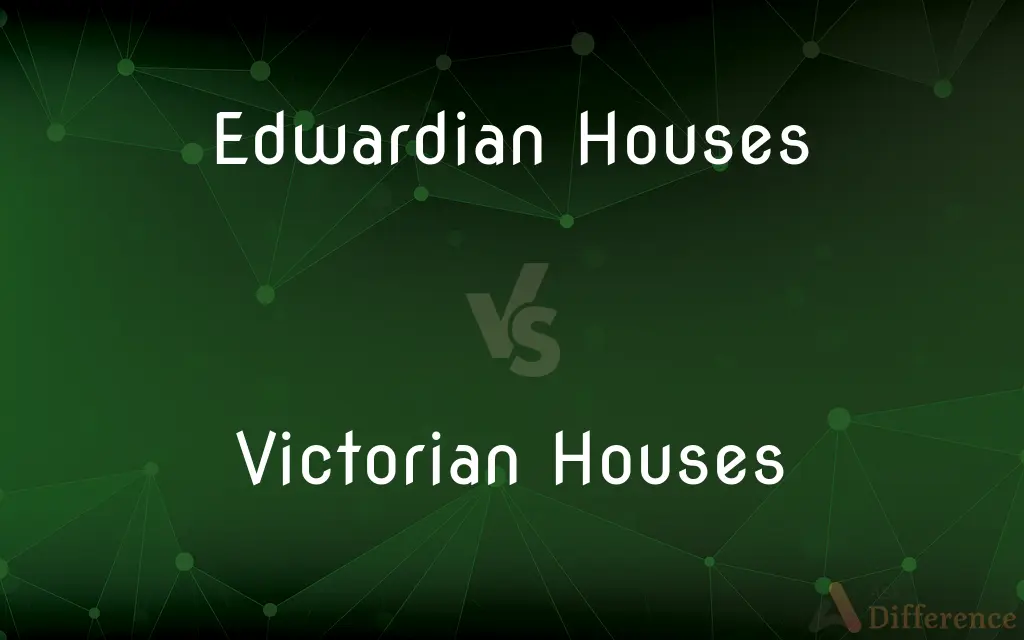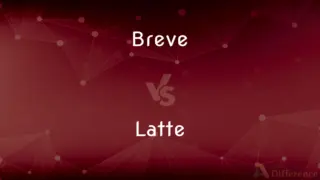Edwardian Houses vs. Victorian Houses — What's the Difference?
Edited by Tayyaba Rehman — By Maham Liaqat — Published on March 8, 2024
Edwardian houses emphasize simplicity and light, with wider halls and simpler decorative elements, while Victorian houses feature ornate details, complex designs, and darker interiors.

Difference Between Edwardian Houses and Victorian Houses
Table of Contents
ADVERTISEMENT
Key Differences
Edwardian and Victorian houses represent distinct historical periods in architecture. Victorian houses, built during Queen Victoria's reign (1837-1901), are known for their intricate designs and ornate detailing. In contrast, Edwardian houses, constructed between 1901 and 1910 during King Edward VII's reign, lean towards a simpler, more airy aesthetic, reflecting societal shifts towards more casual living spaces.
Victorian architecture often features Gothic revival elements, including steep roof pitches, pointed arch windows, and elaborate woodwork. Edwardian homes, meanwhile, tend to have flatter, wider facades with lighter, less cluttered interiors. This shift was partly due to advances in building technology and a growing preference for more functional, less ornate spaces.
In terms of layout, Victorian homes are characterized by their compartmentalized rooms and darker, richer color schemes, which reflected the era's formal living standards. Edwardian houses favor more open, airy layouts with an emphasis on natural light, incorporating large windows and simpler color palettes to create a sense of spaciousness and light.
Decorative elements in Victorian houses include stained glass, intricate plasterwork, and dark, heavy woods, contributing to a sense of opulence and grandeur. Edwardian homes, by comparison, feature more subdued decorations, with an emphasis on handcrafted simplicity and the use of lighter woods, reflecting the Arts and Crafts movement's influence on design philosophy.
The Edwardian era also saw the introduction of more modern amenities and innovations in housing, including the wider use of electricity and indoor plumbing, which influenced house designs to accommodate these new technologies. Victorian homes, while grand, often require significant updates to meet modern living standards in terms of electrical wiring, heating, and plumbing.
ADVERTISEMENT
Comparison Chart
Period
1837-1901
1901-1910
Architectural Style
Gothic revival, ornate detailing
Simpler, functional, Arts and Crafts influence
Layout
Compartmentalized rooms, darker colors
Open, airy layouts, lighter colors
Decorative Elements
Stained glass, intricate plasterwork, dark woods
Lighter woods, simpler decorations, large windows
Technological Innovations
Less emphasis on modern amenities
Incorporated modern amenities like electricity
Compare with Definitions
Edwardian Houses
Influenced by the Arts and Crafts movement.
Handcrafted details and lighter woods were prominent in the Edwardian house's design.
Victorian Houses
Reflects the formal living standards of the era.
The layout of the Victorian house emphasized separate spaces for different activities.
Edwardian Houses
Designed with modern amenities in mind.
The Edwardian house was among the first to incorporate built-in electricity and plumbing.
Victorian Houses
Features intricate woodwork and heavy decoration.
The Victorian house's interior boasted elaborate plasterwork and stained glass.
Edwardian Houses
Favor open layouts and natural light.
The Edwardian house's design focused on creating a seamless flow between rooms.
Victorian Houses
Requires updates for modern amenities.
Renovating the Victorian house included adding modern electrical and plumbing systems.
Edwardian Houses
Emphasize simplicity, light, and airy spaces.
The Edwardian house had a spacious layout with large windows to maximize natural light.
Victorian Houses
Characterized by compartmentalized rooms and darker interiors.
Each room in the Victorian house had its distinct, rich color scheme.
Edwardian Houses
Feature flatter facades and simpler decorative elements.
Unlike Victorian homes, the Edwardian house had a more understated elegance.
Victorian Houses
Known for their ornate detailing and Gothic revival elements.
The Victorian house featured a steeply pitched roof and pointed arch windows.
Common Curiosities
Can you find modern amenities in Victorian houses?
Originally, Victorian houses didn't focus on modern amenities, but many have been updated to include them during renovations.
How do Edwardian houses incorporate natural light?
They feature large windows and lighter colors, with layouts designed to enhance the flow of light throughout the home.
What architectural movement influenced Edwardian houses?
The Arts and Crafts movement, emphasizing handcrafted simplicity and the beauty of natural materials, significantly influenced Edwardian house designs.
Why are Victorian houses darker and more ornate?
Victorian design reflects the era's fascination with Gothic revival and a formal lifestyle, leading to richer color schemes and elaborate detailing.
How do the exteriors of Victorian and Edwardian houses differ?
Victorian houses may feature more complex designs and textures, while Edwardian houses have flatter, wider facades with simpler lines.
Why do Edwardian houses have larger windows?
Larger windows were used to enhance natural light and airiness within the home, reflecting the era's preference for lighter, more open spaces.
What distinguishes Edwardian houses from Victorian houses?
Edwardian houses are noted for their simpler, more functional designs and lighter interiors, contrasting with the ornate and compartmentalized nature of Victorian houses.
Are Edwardian houses more functional than Victorian houses?
Yes, Edwardian houses reflect a shift towards more casual, functional living spaces, with less emphasis on formal room divisions.
What is the typical layout of a Victorian house?
Victorian houses often have a series of compartmentalized rooms, each with a specific function, and decorated in dark, rich colors.
What kind of updates might a Victorian house need?
Victorian homes often require updates for electrical systems, plumbing, heating, and sometimes structural enhancements to meet modern standards.
Share Your Discovery

Previous Comparison
Ltd vs. PLC
Next Comparison
Breve vs. LatteAuthor Spotlight
Written by
Maham LiaqatEdited by
Tayyaba RehmanTayyaba Rehman is a distinguished writer, currently serving as a primary contributor to askdifference.com. As a researcher in semantics and etymology, Tayyaba's passion for the complexity of languages and their distinctions has found a perfect home on the platform. Tayyaba delves into the intricacies of language, distinguishing between commonly confused words and phrases, thereby providing clarity for readers worldwide.














































